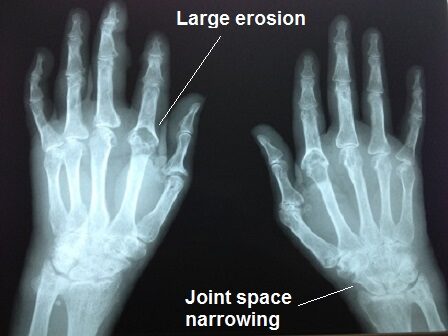Rheumatoid arthritis treatment

There is no cure for rheumatoid arthritis (RA). However, in the recent decades, groundbreaking advances in the treatment of rheumatoid arthritis have made treatment of this disease a lot more successful. While a great number of people with RA needed to be on disability just a few decades ago, nowadays most people with rheumatoid arthritis can expect a relatively normal life. In fact, the current goal in rheumatoid arthritis treatment is remission. If remission is not possible, the goal is to reduce inflammation and pain and prevent joint damage.
Recent research in rheumatoid arthritis has shown that the earlier this disease is treated, the more likely it is to achieve remission. There seems to be a “window of opportunity” during which achieving remission and preventing future joint damage is most probable. This seems to be during the first year after onset of symptoms. As a result, experts recommend early aggressive treatment EARLY, with hopes to reduce treatment once remission is achieved.
Choice of treatment
Lifestyle changes–
Some lifestyle changes can help improve symptoms and quality of life in people with rheumatoid arthritis. These lifestyle changes are used in conjunction with- not in place of- medications used to treat RA. Most people with RA do require medical therapy while the disease is active to prevent joint damage.
- Exercise– despite fatigue, joint pain and stiffness experienced by people with RA, regular exercise is not only safe, but also necessary to prevent loss of muscle strength and deconditioning. The intensity of exercise can be increased as symptoms improve.
- Quit smoking– Smoking is a risk factor for developing rheumatoid arthritis. It also interferes with, and lessons the effects of, medications used to treat RA.
- Diet– some dietary supplements, like fish oil, turmeric and borage seed oil, may have anti-inflammatory properties and may have a modest effect on the symptoms of RA. Please note that these supplements will not cure arthritis. They should be used as supplements to- not replacement of- medical treatment for rheumatoid arthritis.
- Preventative measures– people with rheumatoid arthritis are at an increased risk for heart disease and osteoporosis. Management of traditional risk factors for heart disease- including control of blood pressure, cholesterol, blood sugar, and quitting smoking- is important to lessen the risk of heart disease. Vitamin D supplementation (if deficient in vitamin D) and physical activity can help reduce the risk of osteoporosis.
Medical treatment
Choice of medications in rheumatoid arthritis treatment is usually individualized, depending on the person’s risk factors, comorbid conditions, and potential side effects. Several classes of medications can be used to treat rheumatoid arthritis, and medications from two or more classes may be combined to achieve the desired outcome.
- Nonsteroidal anti-inflammatory drugs (NSAIDS)- examples of this class include ibuprofen (Advil, Motrin), Naproxen (Aleve), Meloxicam (Mobic), Celebrex, Diclofenac (Voltaren), etc. NSAIDs can be used to decrease pain and inflammation. They are rarely used as monotherapy in RA since most patients need stronger medications to decrease the inflammatory burden and to prevent joint damage.
- Disease-modifying anti-rheumatic drugs (DMARDs)
These medications are usually the first ones used for treatment of RA. They are stronger than NSAIDs and, in the long run, safer than steroids. They can take several weeks to take effect so sometimes in severe RA steroids are started at the same time and tapered as DMARDs take effect.
- Methotrexate– this medication has become the first-line medication for rheumatoid arthritis treatment, as it has proven to be very effective at treating symptoms, improving quality of life, and preventing joint damage. It can take 4-6 weeks to see improvement with methotrexate. Although at very high doses, Methotrexate can be used to treat cancer, at the low doses used for rheumatoid arthritis it is NOT chemotherapy. The most common side effects are nausea and abdominal upset. It is contraindicated in pregnancy as it is teratogenic and can cause birth defects. It can affect liver enzymes so alcohol consumption is not recommended. Laboratory monitoring is done periodically; every 1-3 months.
- Sulfasalazine– Sulfasalazine is used in combination with methotrexate or in place of it in those who are intolerant or have contraindications to methotrexate use. It can take 4-8 weeks to see improvement with sulfasalazine. Common side effects include nausea, diarrhea, and rash. Periodic laboratory monitoring every 2-3 months is recommended.
- Leflunomide– Like sulfasalazine, leflunomide is used either in combination or in place of methotrexate in methotrexate cannot be used. It takes 6-8 weeks to see a response. The main side effects are abdominal upset, nausea, diarrhea, and hair loss. Extreme care should be taken for women not to get pregnant while taking this drug as it is teratogenic and can linger in the body for up to 18 months.
- Plaquenil– Plaquenil is sometimes used in mild rheumatoid arthritis alone or in combination with other DMARDs. It can take up to 8-10 weeks for the levels to build up in the body. It is a relatively safe drug with rare and minor side effects including fatigue, body aches or rashes. Deposition of Plaquenil in the retina of the eye causing loss of peripheral vision is a feared potential side effect that is extremely rare and will take years to occur. Yearly eye exams will be able to detect this process early and prevent any vision loss.
- Cyclosporine– is used rarely in rheumatoid arthritis.
- Gold injections– were used in the past and have faded in favor of other more effective treatments like methotrexate.
- Corticosteroids- Examples: Prednisone (oral), solumedrol (IV)
Steroids work quickly and are strong anti-inflammatory agents. Because of potential side effects in the long term use (elevated blood sugar, weight gain, cataracts, osteoporosis, bruising) they are usually used short term when a quick response is required. Low dose steroids (ie. 5mg prednisone or less per day) is fairly safe when used long term.
Biologic drugs
These potent medications have truly revolutionized the treatment of rheumatoid arthritis in the recent decades. These drugs each target a specific component of the immune system, thus “cooling down” an otherwise angry immune system. Infection is a potential, though infrequent, side effect of these drugs. A tuberculosis test is usually required before starting most biologic drugs to rule out dormant or active tuberculosis that can activate once the immune system is lowered. These drugs are usually used in people who have had inadequate response to DMARDs. They are often combined with DMARDs like methotrexate. Several classes of biologics are currently in the market:
TNF-alpha inhibitors (tumor-necrosis-factor inhibitors)- work by blocking the effect of TNF-alpha, an important component of the immune system which causes inflammation and ultimately leads to joint destruction. Recall that people with rheumatoid arthritis are at increased risk of developing lymphoma. There is some debate that TNF inhibitors may increase the risk of lymphoma in these people. Although initial studies reported a minimal increased risk, subsequent large reviews did not find a substantial risk so the issue has remained controversial. There are several members in this family:
- Etanercept (Enbrel)- subcutaneous injection, weekly
- Adalimumab (Humira)- subcutaneous injection, biweekly
- Infliximab (Remicade)- IV infusion, every 2-8 weeks
- Golimumab (Simponi)- subcutaneous injection, monthly
- Golimumab (Simponi Aria)- IV infusion, every 8 weeks
- Certulizumab (Cimzia)- subcutaneous injection, monthly
Abatacept (Orencia)- works by blocking the communication between the B-type and T-type lymphocytes. Orencia comes in both IV (monthly infusion) and subcutaneous (weekly injection) formulations.
Rituxaimab (Rituxan)- monoclonal antibodies against a subtype of B-lymphocytes (B19) that makes them ineffective. This drug is IV and is administered every 6 months. Since it is also a chemotherapy agent, it is often used in rheumatoid arthritis patients with a history of malignancy.
IL-6 inhibitors- these drugs work by nhibiting the function of IL-1, also an important component of the immune system which causes inflammation.
- Tocilizumab (Actemra IV)- IV infusion, every 4 weeks
- Tocilizumab (Actemra SubQ)- subcutaneous injection, biweekly
- Sarilumab (Kevzara)- subcutaneous injection, every 2 weeks
Jak inhibitors- These small molecules work by inhibiting Janus Kinase 1, 2, or 3. They influence DNA transcription, ultimately reducing inflammation. They are taken orally.
- Tofacitinib (Xeljanz)- Oral, 5mg twice daily or 11mg daily
- Baricitinib (Olumient)- Oral, 2mg daily
See also:
Rheumatoid arthritis: diagnosis
Reference:
- http://www.arthritis.org/conditions-treatments/disease-center/rheumatoid-arthritis/
- http://www.rheumatology.org/practice/clinical/patients/diseases_and_conditions/ra.asp
- http://www.mayoclinic.com/health/rheumatoid-arthritis/DS00020
- http://www.uptodate.com/contents/rheumatoid-arthritis-treatment-beyond-the-basics?detectedLanguage=en&source=search_result&search=rheumatoid+arthritis+patient&selectedTitle=1%7E150&provider=noProvider






